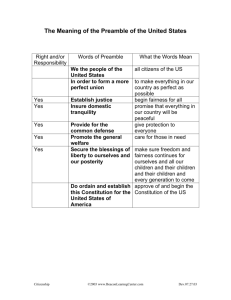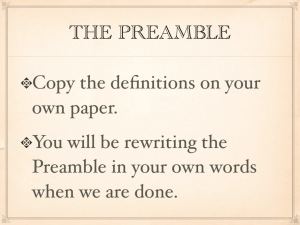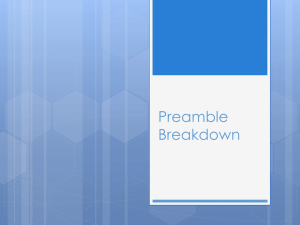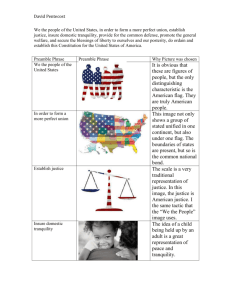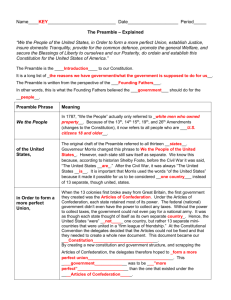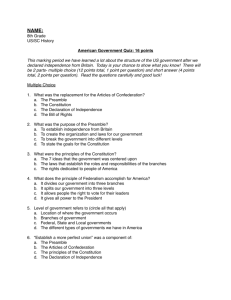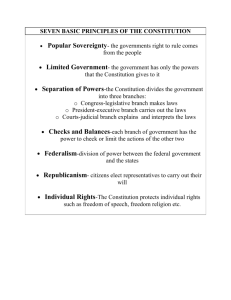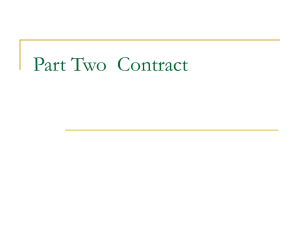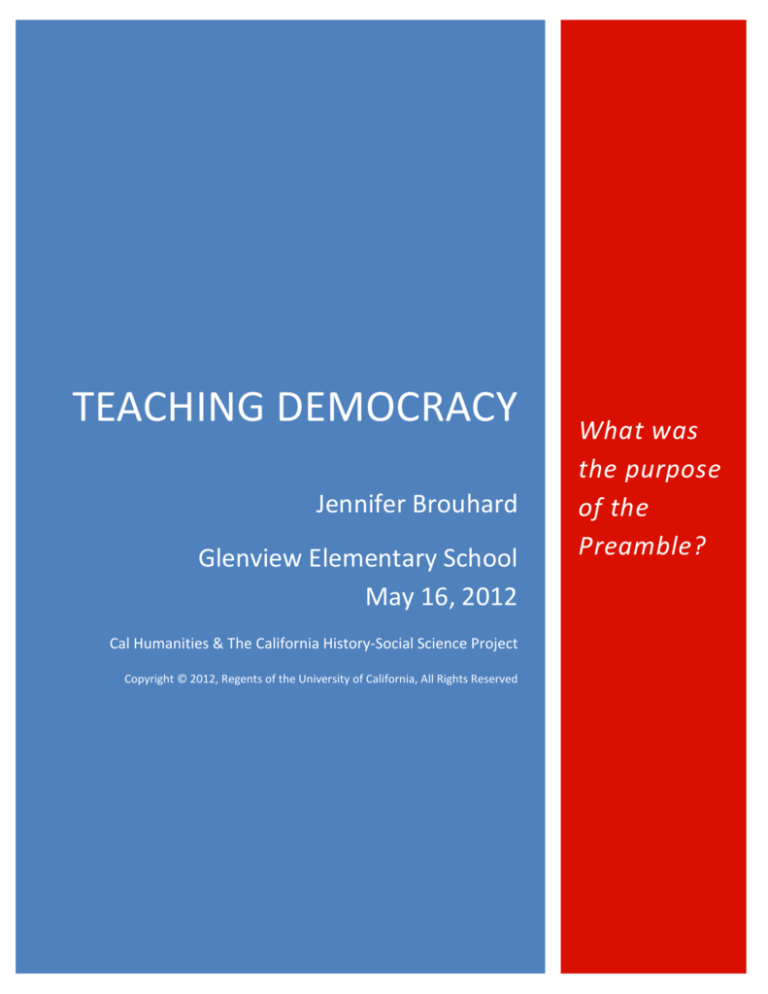
Tee
TEACHING DEMOCRACY
Jennifer Brouhard
Glenview Elementary School
May 16, 2012
Cal Humanities & The California History-Social Science Project
Copyright © 2012, Regents of the University of California, All Rights Reserved
What was
the purpose
of the
Preamble?
Teaching Democracy is a partnership between the California History-Social Science Project (CHSSP) and Cal
Humanities. Teaching Democracy seeks to both deepen student understanding of the history of American
democracy and promote an engaged and knowledgeable citizenry. Our partnership hopes to invigorate K-16
educators to formulate new ways to help students make connections between ideas upon which the United
States was founded and its governance.
Teaching Democracy provides three major curricular resources for teachers and their students:
presentations by leading scholars, selected primary sources, and Standards-aligned curriculum for teachers,
including this lesson. These materials will be distributed in five online webinars scheduled for 2012 and
archived with recorded presentations on the Teaching Democracy website for future classroom use.
About The California History-Social Science Project:
One of nine disciplinary networks that make up the California Subject Matter Projects (CSMP), the California
History-Social Science Project (CHSSP) is headquartered at the University of California, Davis, and its six sites
are housed in the departments of history and geography at university campuses throughout California. Our K16 collaborative is dedicated to providing the highest quality history instruction, with a special focus on
meeting the needs of English learners, native speakers with low literacy, and students from economically
disadvantaged communities. For more information, visit chssp.ucdavis.edu.
About Cal Humanities
Cal Humanities is an independent non-profit organization that promotes the humanities in California to help
create “a state of open mind.” We produce, fund, and support cultural and educational experiences through
media, writings, presentations, and discussion programs. Our aim is to inspire Californians to learn more, dig
deeper, and start conversations that matter among our dramatically diverse people.
Cal Humanities sees the humanities as relevant, meaningful ways to understand the human condition and
connect us to each other in order to become a better California. A state partner of the National Endowment
for the Humanities, we were originally founded in 1975 as a granting organization, but through the years we
have created and implemented our own signature humanities programs and projects. Cal Humanities now
plays a critical role across the state in producing, funding, and supporting cultural experiences and events. For
more information, visit www.calhum.org.
About the Author
Jennifer Brouhard is a 5th grade teacher at Glenview Elementary School in the Oakland Unified School
District. She has presented at numerous summer institutes and conferences including National Council for
History Education, California Council for Social Studies, and the California Council for History Education. In
2009, Ms. Brouhard received the Preserve America Elementary History Teacher of the Year Award, sponsored
by the Gilder Lehrman Institute of American History.
Teaching Democracy: What was the Purpose of the Preamble?
Page 2
Jennifer Brouhard, Author
Copyright ©2012, Regents of the University of California, All Rights Reserved
Table of Contents
The Teaching Democracy Program ................................................................................................................. Page 2
Lesson Introduction ........................................................................................................................................ Page 4
Procedures ...................................................................................................................................................... Page 5
Student Handout 1: Preamble Drafts ............................................................................................................. Page 7
Student Handout 2: Analyzing the Original Preamble .................................................................................... Page 9
Student Handout 3: Analyzing the Preamble .............................................................................................. Page 11
Student Handout 4: In Your Own Words ...................................................................................................... Page 13
Student Handout 5: Pre-Writing Notes ........................................................................................................ Page 15
Student Handout 6: Answering the Focus Question .................................................................................... Page 17
California Content Standards
5.7
Students describe the people and events associated with the development of the U.S.
Constitution and analyze the Constitution's significance as the foundation of the American
republic.
Common Core State Standards
RI5.1 Explain the relationships or interactions between two or more individuals, events, ideas, or
concepts in a historical, scientific, or technical text based on specific information in the text.
W5.1 Write opinion pieces on topics or texts, supporting a point of view with reasons and
information.
W5.1.a Introduce a topic or text clearly, state an opinion, and create an organizational structure in
which ideas are logically grouped to support the writer’s purpose.
W5.1.b Provide logically ordered reasons that are supported by facts and details.
W5.1.d Provide a concluding statement or section related to the opinion presented.
W5.8 Draw on information from multiple print or digital sources, demonstrating the ability to locate
an answer to a question quickly or to solve a problem efficiently.
L5.6 Acquire and use accurately grade-appropriate general academic and domain-specific words
and phrases, including those that signal contrast, addition, and other logical relationships (e.g.,
however, although, nevertheless, similarly, moreover, in addition).
Teaching Democracy: What was the purpose of the Preamble?
Page 3
Jennifer Brouhard, Author
Copyright ©2012, Regents of the University of California, All Rights Reserved
What was the Purpose of the Preamble?
Citation: The Scene at the Signing of the Constitution, oil painting (reproduction) by Howard Chandler Christy, 1940. URL:
http://www.archives.gov/exhibits/charters/charters_of_freedom_zoom_pages/charters_of_freedom_zoom_6.2.1.html
This 5th grade lesson is designed as an introduction to the study of the Constitution. The lesson’s focus on the
language of the Preamble provides teachers with an opportunity to increase student reading comprehension
and disciplinary understanding. Through a close reading of the Preamble, students can further develop their
ability to compare and contrast documents and make their own historical interpretations. In answering the
lesson focus question, What was the Purpose of the Preamble?, students prepare to learn about the rights
and responsibilities detailed in the Constitution and the purpose for its structure of government.
Teaching Democracy: What was the purpose of the Preamble?
Page 4
Jennifer Brouhard, Author
Copyright ©2012, Regents of the University of California, All Rights Reserved
Procedures
Step 1: A First Look at the Preamble (Class Time: 10 minutes)
Introduce the lesson focus question, What was the purpose of the Preamble? Tell students that they will
begin to answer the lesson focus question by reading two different drafts of the Preamble. Constitutional
Convention delegates received the first draft in August 1787. The second is the final text included in the
Constitution that the authors approved on September 17, 1787. Distribute Student Handout 1: Preamble
Drafts. Give students a few minutes to read both versions independently before reading them aloud as a
class. Tell them to annotate the readings—to write notes and circle any differences between the two drafts.
Next, have the students answer the two questions in pairs: 1) What changes do you notice between the first
and final drafts?; and 2) Why do you think the authors of the Constitution made these changes? This exercise
allows students to form initial thoughts about the difference between the Preamble drafts that they will
revisit later.
Step 2: Comparing the Language of the Preamble Drafts (Class Time: 20 minutes)
Students will now closely study the language of each version of the Preamble. Distribute Student Handout 2:
Analyzing the Original Preamble and Student Handout 3: Analyzing the Preamble. This activity,
deconstructing sentences, helps students see how words and phrases are combined to make meaning and
convey information. Students will sort the text into four categories: 1) prepositional phrases that illustrate
time and relationship; 2) nouns and adjectives that show the students the subject of the sentence; 3) action
words such as verbs and adverbs to highlight the action taking place; and 4) nouns and adjectives that show
who or what is receiving the action. Since this activity concentrates on verbs to highlight the actions taking
place, students only have to fill in “Action.” The last column encourages students to ask questions for
clarification, as well as to draw conclusions or analyze the text line by line. The follow-up questions on the
handouts reinforce the idea that the people of the United States have created a government to protect the
personal and national interests of the people for themselves and future generations.
Step 3: Check Student Understanding (5-10 minutes)
Student Handout 2: Analyzing the Original Preamble and Student Handout 3: Analyzing the Preamble are
meant to guide students’ observation and analysis of the Preamble drafts, and to determine key changes to
the final draft. Ask students to share their observations and explain any points they have missed. First,
students should notice that the United States of America has replaced the names of the delegates’ states.
This change is significant as the authors see themselves as part of one united nation rather than as a group of
individual states. In addition, the authority of the government lies with the people who created the
government. The second change is that there is more elaboration about the duties and responsibilities of the
government. Ask students for their thoughts on the changes made between the first and final drafts. Tell
students to add any new insights to their Student Handout 1: Preamble Drafts notes. Have students discuss
Teaching Democracy: What was the purpose of the Preamble?
Page 5
Jennifer Brouhard, Author
Copyright ©2012, Regents of the University of California, All Rights Reserved
in small groups how new observations help answer the focus question. One student from each group can
report their group’s discussion to the class. Finally, have students write on the back of Student Handout 1:
Preamble Drafts what they know, how this will help them answer the focus question, and what they still do
not understand. Based on what they still do not understand, you may need to do some small group or whole
class reteaching.
Step 4: In Your Own Words (Class Time: 10 minutes)
To prepare students for writing (in Step 6 below) and reinforce new learning, this activity gives them practice
with paraphrasing. Have students explain what the Preamble means in their own words on Student Handout
4: In Your Own Words. Students can work on this together but they must be able to explain their choices for
both columns. The varying answers to “What does this mean?” will give teachers a good gauge of student
understanding of the Preamble and reveal which students will have a difficult time with the lesson
assessment.
Step 5: Collecting Evidence (Class Time: 15 minutes)
Distribute Student Handout 5: Pre-Writing Notes. Tell students that the final assignment for the lesson is to
write a paragraph answering the focus question. First, they will need to collect evidence for writing. As a
class read the focus question, background information, introduction, and thesis from the handout. Have
students circle the key words in the focus question and underline the three main arguments of the thesis:
that the purpose of the Preamble was to (1) establish new government by the people and for the people; (2)
explain the role of the government; and (3) promote the shared responsibility of ensuring a free government.
Students will work in groups to find the words in the Preamble that support the thesis. The graphic organizer
supports their note taking. For the “Paraphrase” column, tell students to explain how words from the
Preamble are evidence of the three main arguments.
Step 6: Answering the Focus Question (15 minutes)
Students will now answer the lesson focus question. Have students refer to all their previous lesson notes to
complete Student Handout 6: Answering the Focus Question. The sentence frames will guide students
through the process of synthesizing the evidence and making interpretations based upon the primary source
(the Preamble). Explain to the students that the information for each of the prompts (i.e., “First,” “Second,”
“Finally”) can be found in Student Handout 5: Pre-Writing Notes, listed as the three main arguments.
Students can quote from the Preamble or paraphrase in their own words. The written analysis of the text will
guide students to identify the purpose of the Preamble.
Teaching Democracy: What was the purpose of the Preamble?
Page 6
Jennifer Brouhard, Author
Copyright ©2012, Regents of the University of California, All Rights Reserved
Student Handout 1: Preamble Drafts
First Draft: Distributed to Constitutional Convention delegates in August 1787
Library of Congress, Rare Book and Special Collections Division, Alfred Whital Stern Collection of Lincolniana.
[http://hdl.loc.gov/loc.rbc/bdsdcc.c01a1]
Final Draft: Signed by Constitutional Convention delegates on September 17, 1787
Library of Congress, Rare Book and Special Collections Division, Continental Congress & Constitutional Convention Broadsides
Collection [http://hdl.loc.gov/loc.rbc/bdsdcc.c0801]
1) What changes do you notice between the first and final draft?
2) Why do you think the authors of the Constitution made these changes?
Teaching Democracy: What was the purpose of the Preamble?
Page 7
Jennifer Brouhard, Author
Copyright ©2012, Regents of the University of California, All Rights Reserved
Student Handout 1K: Preamble Drafts
First Draft: Distributed to Constitutional Convention delegates in August 1787
Library of Congress, Rare Book and Special Collections Division, Alfred Whital Stern Collection of Lincolniana.
[http://hdl.loc.gov/loc.rbc/bdsdcc.c01a1]
Final Draft: Signed by Constitutional Convention delegates on September 17, 1787
Library of Congress, Rare Book and Special Collections Division, Continental Congress & Constitutional Convention Broadsides
Collection [http://hdl.loc.gov/loc.rbc/bdsdcc.c0801]
1) What changes do you notice between the first and final draft? In the first draft, the first sentence begins,
“We the People of the states of,” and lists the 13 states. In the second version the states are not listed, and
the authors wrote “We, the People of the United States” instead. The second draft is much longer.
2) Why do you think the authors of the Constitution made these changes? By writing the United States and
not listing each of the 13 states the authors wanted to show that the states now made up one unified nation.
Teaching Democracy: What was the purpose of the Preamble?
Page 8
Jennifer Brouhard, Author
Copyright ©2012, Regents of the University of California, All Rights Reserved
Student Handout 2: Analyzing the Original Preamble
We the People of the states of New Hampshire, Massachusetts, Rhode Island and Providence
Plantations, Connecticut, New York, New Jersey, Pennsylvania, Delaware, Maryland, Virginia, North Carolina,
South Carolina and Georgia, do ordain, declare and establish the following Constitution for the government of
ourselves and our posterity.
Circle the Verbs: Circle the verbs in the passage above and write the verbs you circled in the box below.
Break Down the Text
Prep/Time
Subject
Action
Marker
We the People of the
states of New
Hampshire,
Massachusetts, Rhode
Island and Providence
Plantations, Connecticut,
New York, New Jersey,
Pennsylvania, Delaware,
Maryland, Virginia,
North Carolina, South
Carolina and Georgia
for the
government of
ourselves and our
posterity
Who or what is
getting the action
the following
Constitution
Questions/
Conclusions
1) Who created the government?
2) Where did the government get its power?
3) Who was the Constitution and the government created for?
Teaching Democracy: What was the purpose of the Preamble?
Page 9
Jennifer Brouhard, Author
Copyright ©2012, Regents of the University of California, All Rights Reserved
Student Handout 2K: Analyzing the Original Preamble
We the People of the states of New Hampshire, Massachusetts, Rhode Island and Providence
Plantations, Connecticut, New York, New Jersey, Pennsylvania, Delaware, Maryland, Virginia, North Carolina,
South Carolina and Georgia, do ordain, declare and establish the following Constitution for the government of
ourselves and our posterity.
Circle the Verbs: Circle the verbs in the passage above and write the verbs you circled in the box below.
do ordain
declare
establish
Break Down the Text
Prep/Time Marker
Subject
Action
We the People
of the states of
New Hampshire,
Massachusetts, Rhode
Island and Providence
Plantations, Connecticut,
New York, New Jersey,
Pennsylvania, Delaware,
Maryland, Virginia, North
Carolina, South Carolina
and Georgia
do ordain
declare
and establish
for the government
of ourselves and our
posterity
Who or what is
getting the action
the following
Constitution
Questions/
Conclusions
Possible responses…
What is a
Constitution?
Who are “our
posterity?”
Why does the
Preamble need three
similar verbs?
All 13 states are in
support of the
Constitution.
1) Who created the government?
The people of the states listed under “Subject.”
2) Where did the government get its power?
The people of the states listed under “Subject.” Students may also say that the Constitution grants power to
the government (created by the people of all the states listed under “Subject.”)
3) Who was the Constitution and the government created for?
For the people of the states listed under “Subject.”
Teaching Democracy: What was the purpose of the Preamble?
Page 10
Jennifer Brouhard, Author
Copyright ©2012, Regents of the University of California, All Rights Reserved
Student Handout 3: Analyzing the Preamble
We the people of the United States, in order to form a more Perfect Union, establish justice, insure
domestic tranquility, provide for the common defense, promote the general welfare, and secure the blessings
of liberty to ourselves and our posterity, do ordain and establish this Constitution for the United States of
America.
Circle the Verbs: Circle the verbs in the passage above and write the verbs you circled in the box below.
Break Down the Text
Prep/Time Marker Subject
Action
Who or what is getting
the action
Questions/Conclusions
We, the
people of
the United
States of
America,
in order
and
____________
a more Perfect Union
justice
domestic tranquility
for the common defense
the general welfare
the blessings of liberty to
ourselves and our
posterity
this Constitution
for the United
States of America
1) Who is creating the government?
2) Where did the government get its power?
3) What is the purpose of the government?
Teaching Democracy: What was the purpose of the Preamble?
Page 11
Jennifer Brouhard, Author
Copyright ©2012, Regents of the University of California, All Rights Reserved
Student Handout 3K: Analyzing the Preamble
We the people of the United States, in order to form a more Perfect Union, establish justice, insure
domestic tranquility, provide for the common defense, promote the general welfare, and secure the blessings
of liberty to ourselves and our posterity, do ordain and establish this Constitution for the United States of
America.
Circle the Verbs: Circle the verbs in the passage above and write the verbs you circled in the box below.
To form
establish
insure provide
Break Down the Text
Prep/Time Marker
Subject
promote
Action
secure do ordain
Who or what is
getting the action
We, the people
of the United
States of
America,
In order
Questions/Conclusions
Possible responses…
What happened to all
the states?
to form
establish
insure
provide
promote
and secure
do ordain and
establish
for the United States
of America
establish
a more Perfect
Union
justice
domestic tranquility
for the common
defense
the general welfare
the blessings of
liberty to ourselves
and our posterity
this Constitution
This Preamble is much
more detailed than the
draft.
Vocabulary questions
Why are all these details
necessary? Some of
them are very similar.
The authors kept the
verbs “ordain and
establish.”
1) Who is creating the government? The people of the United States
2) Where did the government get its power? The people of the United States
3) What is the purpose of the government? To form a perfect union, establish justice, insure domestic
tranquility, provide for the common defense, promote the general welfare, and secure the blessings of liberty
to ourselves and our posterity.
Teaching Democracy: What was the purpose of the Preamble?
Page 12
Jennifer Brouhard, Author
Copyright ©2012, Regents of the University of California, All Rights Reserved
Student Handout 4: In Your Own Words
Instructions: From the list below choose the correct paraphrased statement and write it in the middle column.
•
•
•
•
•
•
•
encourage the wellbeing of all
create fair laws and courts
We, the people of America, in order to build a better country
guarantee peace
grant permission to create a new nation through the authority of the Constitution
will protect the country
insure freedom for Americans now and the future
The Preamble says…
Choose and write the correct
paraphrased statement from
above
What does this mean?
We, the People of the
United States, in order to
form a more perfect
union,
establish justice,
ensure domestic tranquility,
provide for the common
defense,
promote the general
welfare,
and secure the blessings of
liberty to ourselves and our
posterity,
do ordain and establish
this Constitution for the
United States of America.
Teaching Democracy: What was the purpose of the Preamble?
Page 13
Jennifer Brouhard, Author
Copyright ©2012, Regents of the University of California, All Rights Reserved
Student Handout 4K: In Your Own Words
Instructions: From the list below choose the correct paraphrased statement and write it in the middle column.
•
•
•
•
•
•
•
encourage the wellbeing of all
create fair laws and courts
We, the people of America, in order to build a better country
guarantee peace
grant permission to create a new nation through the authority of the Constitution
will protect the country
insure freedom for Americans now and the future
The Preamble says…
Choose and write the correct
paraphrased statement from above
What does this mean?
These answers will vary but they should give
you a good sense of student comprehension.
We, the People of the United
States, in order to form a
more perfect union,
We, the people of America, in order to
build a better country
The people of America want to create a better
government than the Articles of Confederation.
establish justice
create fair laws and courts
I am protected by fair laws and have rights if I
go to court.
ensure domestic tranquility,
guarantee peace
The United States will be a peaceful country.
provide for the common
defense,
will protect the country
The government will protect the country from
harm.
promote the general
welfare,
encourage the wellbeing of all
We all want to be well.
and secure the blessing of
liberty to ourselves and our
posterity
do ordain and establish this
Constitution for the United
States of America.
ensure freedom for Americans now
and in the future
I live in a free country and future generations
will too.
grant permission to create a new
nation through the authority of the
Constitution
The people give permission to establish a new
government with the Constitution.
The people of America are creating a better
United States government.
Teaching Democracy: What was the purpose of the Preamble?
Page 14
Jennifer Brouhard, Author
Copyright ©2012, Regents of the University of California, All Rights Reserved
Student Handout 5: Pre-Writing Notes
Writing Prompt
Focus Question: What was the purpose of the Preamble?
Background:
The Constitutional Convention delegates approved the final draft of the
Constitution on September 17, 1787.
Introduction and Thesis:
The Preamble is the introduction to the Constitution. Its purpose is to: (1)
establish a government that is by the people and for the people; (2) explain the
role of the new government; and (3) promote a shared responsibility to
maintain and protect a free government.
Evidence from the Preamble
Paraphrase (write in your own words)
Who:
Who:
What:
What:
Shared
responsibility
Role of government
Establish new
government
Instructions: Your next assignment will be to write a paragraph answering the focus question. The thesis is
written above. It has three main arguments. You will need to collect evidence for the three main arguments
from the Preamble. Using your notes from Student Handout 4: In Your Own Words as an example, complete
the “Paraphrase” column. You will use these notes to write your final paragraph.
Teaching Democracy: What was the purpose of the Preamble?
Page 15
Jennifer Brouhard, Author
Copyright ©2012, Regents of the University of California, All Rights Reserved
Student Handout 5K: Pre-Writing Notes
Writing Prompt
Focus Question: What was the purpose of the Preamble?
Background:
The Constitutional Convention delegates approved the final draft of the
Constitution on September 17, 1787.
Introduction and Thesis:
The Preamble is the introduction to the Constitution. Its purpose is to: (1)
establish a government that is by the people and for the people; (2) explain the
role of the new government; and (3) promote a shared responsibility to
maintain and protect a free government.
Shared
responsibility
Role of
Government
Establish new
government
Instructions: Your next assignment will be to write a paragraph answering the focus question. The thesis is
written above. It has three main arguments. You will need to collect evidence for the three main arguments
from the Preamble. Using your notes from Student Handout 4: In Your Own Words as an example, complete
the “Paraphrase” column. You will use these notes to write your final paragraph.
Evidence from the Preamble
Paraphrase (write in your own words)
Who: We, the people
Who: The people of the United States,
Americans
What: to form a more perfect union
What: to create a better or improved
government (nation, country)
Do ordain and establish this Constitution for the
United States of America
Establish justice
Insure domestic tranquility
Provide for the common defense
Promote general welfare
Do create this Constitution for the people of
the United States of America
fair laws and court
peaceful homes and communities
protection, military, police
take care of the American people
Secure the blessings of liberty on ourselves and our Protect liberty for ourselves and future
posterity
generations
Teaching Democracy: What was the purpose of the Preamble?
Page 16
Jennifer Brouhard, Author
Copyright ©2012, Regents of the University of California, All Rights Reserved
Student Handout 6: Answering the Focus Question
Paragraph frame
Constitutional Convention delegates approved the final draft of the Constitution on September 17,
1787. The Preamble is the introduction to the Constitution. Its purpose is to: (1) establish a government that
is by the people and for the people; (2) explain the role of the new government; and (3) promote a shared
responsibility to maintain and protect a free government. First, the authors of the Constitution
Second, the Preamble said the new government would
Finally, the authors of the Constitution explained
.
Teaching Democracy: What was the purpose of the Preamble?
Page 17
Jennifer Brouhard, Author
Copyright ©2012, Regents of the University of California, All Rights Reserved
Student Handout 6K: Answering the Focus Question
Paragraph frame
Constitutional Convention delegates approved the final draft of the Constitution on September 17,
1787. The Preamble is the introduction to the Constitution. Its purpose is to: (1) establish a government that
is by the people and for the people; (2) explain the role of the new government; and (3) promote a shared
responsibility to maintain and protect a free government. First, the authors of the Constitution used the
words, “We, the People” and “to form a more perfect union” to create a new and better government for all.
Second, the Preamble said the new government would take care of the American people, provide fair laws
and courts, and protect the country. Finally, the authors of the Constitution explained the shared
responsibility of the people and the government to “secure the blessings of liberty” and to protect these
basic rights for future generations to come.
Teaching Democracy: What was the purpose of the Preamble?
Page 18
Jennifer Brouhard, Author
Copyright ©2012, Regents of the University of California, All Rights Reserved

